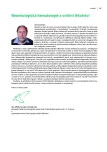-
Medical journals
- Career
Paroxysmal nocturnal hemoglobinuria
Authors: Jaroslav Čermák 1,2
Authors‘ workplace: Ústav klinické a experimentální hematologie 1. LF UK, Praha 1; Ústav hematologie a krevní transfuze, Praha 2
Published in: Vnitř Lék 2018; 64(5): 508-513
Category:
Overview
Paroxysmal nocturnal hemoglobinuria (PNH) results from a deficiency in inhibitors of activated complement. This lack leads to complement mediated intravascular hemolysis, to activation of coagulation system with increased risk of thrombotic complications and to various degree of bone marrow failure. A molecular basis of PNH is a somatic mutation of PIGA gene causing a lack of glycosyl phosphatidyl inositol which binds many important antigens to cell surface membrane including inhibitors of activated complement CD59 and CD55 antigens. Presence of CD59 and CD55 deficient cells in peripheral blood detected by flow cytometry is essential for diagnosis of PNH. Standard treatment of PNH includes transfusions of leukocyte depleted red blood cells, anticoagulation prophylaxis and administration of folinic acid. PNH patients with predominant signs of bone marrow failure and profound cytopenia may by candidates for stem cell transplantation or combination immunosuppression. Patients with severe hemolysis and/or thrombotic complications are indicated for administration of eculizumab – a monoclonal antibody against C5 part of complement.
Key words:
diagnosis – eculizumab – immunosuppression – paroxysmal nocturnal hemoglobinuria – pathogenesis – transplantation – treatment
Sources
- Gargiulo M, Papaionnaou L, Sica M et al. Glycosylphosphatidylinositol-specific, CD1d-restricted T cells in paroxysmal nocturnal hemoglobinuria, Blood 2013; 121(14): 2753–2761. Dostupné z DOI: <http://dx.doi.org/10.1182/blood-2012–11–469353>.
- Inoue N, Izui-Sarumaru T, Murakami Y et al. Molecular basis of clonal expansion of hematopoiesis in 2 patients with paroxysmal nocturnal hemoglobinuria (PNH). Blood 2006; 108(13): 4232–4236. Dostupné z DOI: <http://dx.doi.org/10.1182/blood-2006–05–025148>.
- Marinov I, Luxova A, Tkacova V et al. Common, standardized and recommended approaches in the diagnosis and monitoring of paroxysmal nocturnal haemoglobinuria using flow cytometry. Vnitř Lék 2012; 58(1): 31–37.
- Brodsky RA. Paroxysmal nocturnal hemoglobinuria. Blood 2015; 124(18): 2804–2811. Dostupné z DOI: <http://dx.doi.org/10.1182/blood-2014–02–522128>.
- Parker C, Omine M, Richards S et al. International PNH Interest Group. Diagnosis and management of paroxysmal nocturnal hemoglobinuria. Blood 2005; 106(12): 3699–3709. Dostupné z DOI: <http://dx.doi.org/10.1182/blood-2005–04–1717>.
- Hill A, Kelly RJ, Hillmen P Thrombosis in paroxysmal nocturnal hemoglobinuria. Blood 2013; 121(25): 4985–4996. Dostupné z DOI: <http://dx.doi.org/10.1182/blood-2012–09–311381>.
- Luzzatto L, Gianfaldoni G, Notaro R. Management of paroxysmal nocturnal haemoglobinuria: a personal view. Br J Haematol 2011; 153(6): 709–720. Dostupné z DOI: <http://dx.doi.org/10.1111/j.1365–2141.2011.08690.x>.
- Hall C, Richards S, Hillmen P. Primary prophylaxis with warfarin prevents thrombosis in paroxysmal nocturnal hemoglobinuria. Blood 2003; 102(10): 3587–3592. Dostupné z DOI: <http://dx.doi.org/10.1182/blood-2003–01–0009>.
- Kelly RJ, Hill A, Arnold LM et al. Long-term treatment with eculizumab in paroxysmal nocturnal hemoglobinuria: sustained efficacy and improved survival. Blood 2011; 117(25): 6786–6792. Dostupné z DOI: <http://dx.doi.org/10.1182/blood-2011–02–333997>.
- Tichelli A, Schrezenmeier H, Socie G et al. A randomized controlled study in patients with newly diagnosed severe aplastic anemia receiving antithymocyte globulin (ATG), cyclosporine, with or without G-CSF: a study of the SAA Working Party of the European Group for Blood and Marrow Transplantation. Blood 2011; 117(17): 4434–4441. Dostupné z DOI: <http://dx.doi.org/10.1182/blood-2010–08–304071>.
- Peffault de Latour R, Schrezenmeier H, Bacigalupo A et al. Allogeneic stem cell transplantation in paroxysmal nocturnal hemoglobinuria. Haematologica 2012; 97(11): 1666–1673. Dostupné z DOI: <http://dx.doi.org/10.3324/haematol.2012.062828>.
- Hillmen P, Young NS, Schubert J et al. The complement inhibitor eculizumab in paroxysmal nocturnal hemoglobinuria. N Engl J Med 2006; 355(12): 1233–1243. Dostupné z DOI: <http://dx.doi.org/10.1056/NEJMoa061648>.
- Hillmen P, Muus P, Duhrsen U et al. Effect of the complement inhibitor eculizumab on thromboembolism in patients with paroxysmal nocturnal hemoglobinuria. Blood 2007; 110(12): 4123–4128. Dostupné z DOI: <http://dx.doi.org/10.1182/blood-2007–06–095646>.
- Hillmen P, Elebute M, Kelly R et al. Long-term effect of the complement inhibitor eculizumab on kidney function in patients with paroxysmal nocturnal hemoglobinuria. Am J Hematol 2010; 85(8): 553–559. Dostupné z DOI: <http://dx.doi.org/10.1002/ajh.21757>. Erratum in Am J Hematol 2010; 85(11): 911.
- Kelly RJ, Hochsmann B, Szer J et al. Eculizumab in pregnant patients with Paroxysmal nocturnal hemoglobinuria. New Engl J Med 2015; 373(11): 1032–1039. Dostupné z DOI: <http://dx.doi.org/10.1056/NEJMoa1502950>.
Labels
Diabetology Endocrinology Internal medicine
Article was published inInternal Medicine

2018 Issue 5-
All articles in this issue
- Differential diagnosis of anemia
- Hemoglobinopathies
- Rare anemias from the group of congenital bone marrow failure syndromes
- Aplastic anemia
- Paroxysmal nocturnal hemoglobinuria
- Autoimmune hemolytic anemia
- Granulocytopenia
- Diagnosis and treatment of immune thrombocytopenia
- Hematopoietic stem cell transplantation for non-malignant hematological disorders
- Diagnostic strategies in disorders of hemostasis
- Congenital and acquired bleeding disorders
- Investigation of congenital thrombophilic conditions: when, in whom, focusing on what or not at all?
- Antithrombotics today
- Internal Medicine
- Journal archive
- Current issue
- Online only
- About the journal
Most read in this issue- Autoimmune hemolytic anemia
- Differential diagnosis of anemia
- Congenital and acquired bleeding disorders
- Hemoglobinopathies
Login#ADS_BOTTOM_SCRIPTS#Forgotten passwordEnter the email address that you registered with. We will send you instructions on how to set a new password.
- Career

